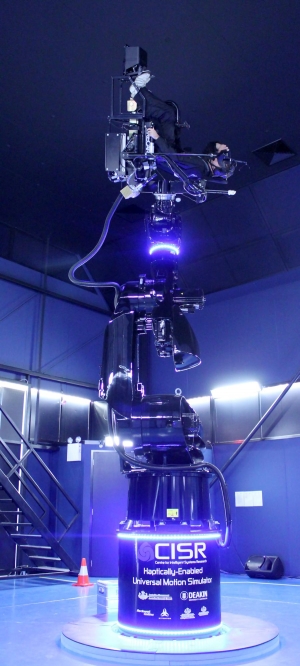The next generation of flight simulation
Research news
It might look like a state-of-the-art theme park ride, but the thrills with Deakin University’s latest innovation will only be experienced by the likes of future jet fighter pilots.
Unveiled at Deakin’s Geelong Waurn Ponds Campus today (Friday 18 November) by Federal Innovation Minister Kim Carr, Deakin’s Universal Motion Simulator (UMS) will take trainee pilots and drivers through their paces in a safer, cheaper and more realistic training environment than currently available elsewhere in the world.
“This next generation simulator uses its oversized robot arm to spin users at high speeds in any direction,” explained Professor Saeid Nahavandi, the Director of Deakin’s Centre for Intelligent Systems Research (CISR).
“No other simulator can provide the full experience of flying a military jet with all the gut wrenching G-forces while only seven metres off the ground.
“While suited for training pilots, the UMS is also the perfect platform for simulating land based vehicles including tanks and other armoured vehicles, trucks, race cars and motorbikes. Its training capabilities are endless.”
With the UMS, Professor Nahavandi and his team have taken motion simulators to a whole new level.
“Standard simulators replicate the flying or driving experience by merely tilting from side-to-side and providing the ‘real life’ sensation through visual cues,” Professor Nahavandi said.
“What sets the UMS apart from standard simulators is the integration of haptics technology, which provides a sense of touch and feel to virtual or remote objects, and its ability move at high speed and in any direction.
“Combined with a high resolution 3D display mounted inside a headset, the user is totally immersed in the set training environment and has a ‘real’ experience – both visually and physically.”
Professor Nahavandi thanked Minister Carr for launching the UMS.
“The Federal Government has supported the development of the UMS through Australian Research Council funding,” he said. “Without this funding, the facility would not be up and running today.”
The University has received $1.8million in ARC/CRC grants towards the establishment of the facility that houses the UMS, including a $ 285,000 ARC Linkage-Infrastructure and Equipment Facilities Program grant in 2008.
ARC Linkage funding of $210,000 was recently announced for a flight simulation project starting at the CISR in 2012 and an additional $3.9million has been received from the Commonwealth to undertake security-related projects.
More about the Universal Motion Simulator
Robotic experts in Deakin’s Centre for Intelligent Systems Research have integrated the latest in haptics technology to a specially constructed robotic system. It is essentially a giant industrial robot arm with a reach of seven metres, has a seat attached to the end of it and the capability to exert up to 6 Gs of force – ideal for flight simulation.
Haptics adds a sense of touch and feel to virtual or remote objects. The technology generates forces and vibrations that simulate a realistic sense of touch and feel to the user through devices such as a joystick or steering wheel. Combined with a high resolution 3D display mounted inside a headset, the user is totally immersed in the set training environment and has a “real” experience – both visually and physically.
Future pilots of Australia’s fighter jets will be able to learn intricate manoeuvres just seven metres from the ground using this next generation flight simulator. It can also be configured to simulate the space shuttle, helicopters as well as land based vehicles including tanks and other armoured vehicles, trucks, race cars and motor bikes.
Using this simulator reduces training liability with less reliance on physical equipment therefore reducing cost and risks to trainees.
With pilot training, the UMS can simulate the intricate movement required by military pilots for disaster recovery such engine failure; take them through fast jet training by totally immersing them in continuous aileron rolls (the fancy aerobatic manoeuvre in which the aircraft does a 360 degree spin while staying on course); and provide the full experience of flying a military jet with all the gut wrenching G-forces while only seven metres off the ground.
There is also the capability of simulating dog fights and other joint flying experiences with pilots who are based in other parts of the world, such as the United States. This level of remote collaboration also allows for pilot instructor training to take place where the trainer, for example, is in Australia and the trainee in the US.
Through all these experiences haptics allows the pilot to feel the aircraft stick move realistically in their hands and the headset provides the real-life visual cues.
The UMS can also determine the pilot’s physical and mental responses through EEG (electroencephalogram usually reserved for hospitals) that monitors the brain, as well as an ECG (electrocardiogram) pulse and blood pressure.
Share this story
 The Universal Motion Simulator.
The Universal Motion Simulator.
